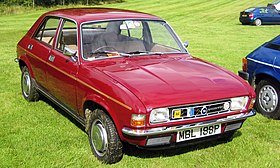Vanden Plas 1500
| Austin Allegro | |
|---|---|
 |
|
| Overview | |
| Manufacturer | Austin (British Leyland) |
| Also called | Vanden Plas 1500 Vanden Plas 1.5 Vanden Plas 1.7 Innocenti Regent |
| Production | 1973–1982 |
| Assembly |
Longbridge Seneffe Milan |
| Body and chassis | |
| Class | Compact car / Small family car (C) |
| Body style | 2-door saloon 3-door estate 4-door saloon |
| Layout | FF layout |
| Related | Innocenti Regent |
| Powertrain | |
| Engine | 1.0 L A-Series I4 1.1 L A-Series I4 1.3 L A-Series I4 1.5 L E-Series I4 1.7 L E-Series I4 |
| Dimensions | |
| Wheelbase | 2,438 mm (96 in) |
| Length | 3,861 mm (152 in) |
| Width | 1,600 mm (63 in) |
| Height | 1,397 mm (55 in) |
| Kerb weight | 869 kg (1,915 lb) (approx) |
| Chronology | |
| Predecessor | Austin 1100/1300 |
| Successor | Austin Metro |
The Austin Allegro is a small family car that was manufactured by Austin from 1973 until 1982. The same vehicle was built in Italy by Innocenti between 1974 and 1975 and sold as the Innocenti Regent. In total, 642,350 Austin Allegros were produced during its ten-year production life, most of which were sold on the home market.
The Allegro announced in May 1973 was designed as the replacement for the Austin 1100 and 1300 models, designed by Sir Alec Issigonis. As with the Morris Marina, the car can be seen with hindsight as symptomatic of the enormous difficulties facing British Leyland during that period. The key factor that British Leyland can now be seen to have missed is that a much more useful and popular form of car, the hatchback, was emerging in Europe, with designs such as the Autobianchi A112, Renault 16, and Volkswagen Golf. This configuration would go on to dominate the market for small family cars in the space of a few years. British Leyland stuck to the more traditional and less versatile booted design when they launched the Allegro. This was because of internal company politics: it had been decided that the Austin Maxi should have a hatchback as its unique selling point, and that no other car in the company's line-up was allowed one. This decision hamstrung both the Allegro and the Princess, both designs naturally suited to a hatchback yet not given one.
The Allegro used front-wheel drive, using the familiar A-Series engine with a sump-mounted transmission. The higher-specification models used the SOHC E-Series engine (from the Maxi), in 1500 cc and 1750 cc displacements. The two-box saloon bodyshell was suspended using the new Hydragas system (derived from the previous Hydrolastic system used on the 1100/1300).
...
Wikipedia
